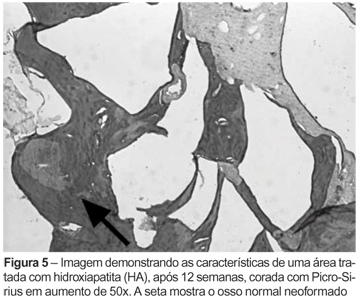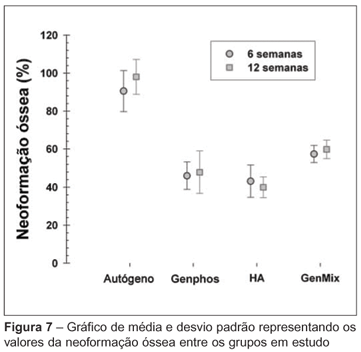OBJECTIVE: Compare the percentage of bone neoformation promoted by autologous bone grafting and three kinds of replacement materials with different characteristics in rats' femoral holes. METHODS: Two holes measuring 5.4 x 2.7mm, were produced on each femur (right and left) of 14 isogenic Wistar rats. Each of the four defects produced was filled by autologous bone or by one of three tested materials - hydroxyapatite (HA), Genphos® (HA+ β-TCP) and GenMix® (a combined bovine bone graft). In the end of the 6-week (n = 6) and 12-week (n = 8) periods, the animals were sacrificed. The sections (stained with Picro-Sirius) were assessed by optical microscopy and specific software. RESULTS: The groups with autologous bone were shown to be significantly superior to the others at both assessed times, showing a mean bone formation rate ± SD of 90.6 ± 10.8% in six weeks, and 98 ± 9.2% in 12 weeks (p > 0.0001 for both assessed times). In six weeks, the results for the other groups were the following: Genphos®, 46 ± 7.1%; HA, 43.1 ± 8.4%; and GenMix®, 57.3 ± 4.5%. In 12 weeks: Genphos®, 47.8 ± 11.1%; HA, 39.9 ± 5.4%; GenMix®, 59.7 ± 4.8%, significant (p = 0.007). CONCLUSIONS: In both assessed times, the three bone replacement materials tested in the study showed to be inferior to autologous bone graft for bone neoformation percentage.
Bone regeneration; Bone transplantation; Durapatite; Calcium phosphates; Transplantation, heterotopic; Transplantation, autologous; Biocompatible materials; Rats, Wistar











